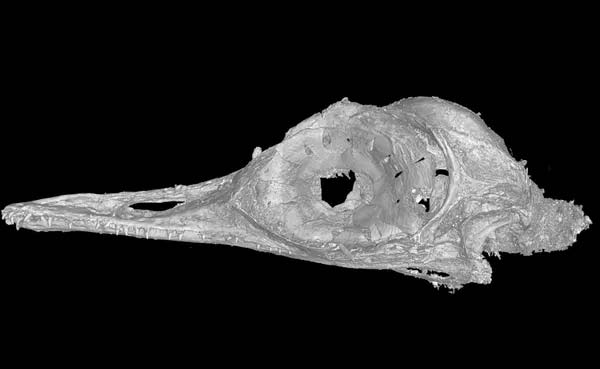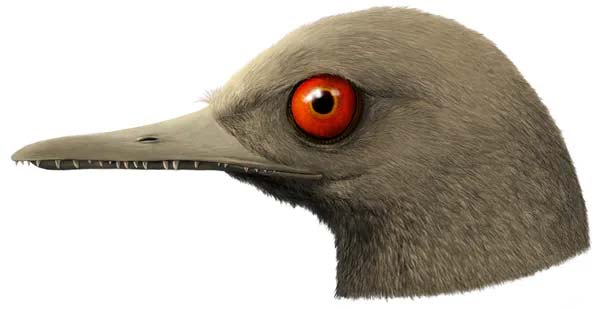Secrets about the world's smallest dinosaur revealed in amber 99 million years old
Recently, an international team of archaeologists found an amber stone estimated to be 99 million years old in the northern Kachin province of Myanmar. However, what makes the global scientists 'wave' is a part of the skull measuring just 31mm x 20 mm x 8.5mm of animals that look almost like today's birds, preserved almost intact. integrity inside the amber tablet.

After a series of in-depth analyzes and assessments, it was concluded that the skull belonged to an Oculudentavis khaungraae - a microscopic, flying-like dinosaur. flies, and lives in the middle of the Cretaceous, from a period called Cenomanian, more than 100 million years ago.
To reach this conclusion, researchers from China and the United States resorted to CT analysis techniques (computed tomography, using X-rays to produce a series of cross-sectional images of the sample. ) to examine the inner structure of the skull. From the data collected, they successfully recreated the 3D image of a typical Oculudentavis khaungraae with a length of 5cm, weighs about 28gr, which is smaller than the current hummingbird. This microscopic dinosaur has a long, slender beak, a mouth with pointed teeth (about 100) and large eyes, similar to those of lizards. The animal's skull still appears to be made up of actual bones, although the microstructure and cell content have not been specifically analyzed.


More specifically, the skin in the area of the mouth and tongue is preserved quite intact.
Researchers have shown that animals that evolve for smaller body sizes tend to come from isolated environments like islands. For example, there have been dwarf mammoths on Crete, Sardinia and Cyprus. Coincidentally, geologists also discovered that Myanmar's large amber mines were formed on an island hundreds of millions of years ago that was part of a volcanic arc on the edge of the ancient Thethys Ocean. Great.
Unfortunately in this amber only store the head of the animal. However, it is possible that the body is also preserved in another amber that we have yet to discover.
Fossils of a prehistoric 127 million year old baby bird
You should read it
- A new breed of turkey dinosaurs found in Australia
- Giant bat fossils have been discovered
- Dinosaurs have used colors to camouflage
- The 66-million-year-old rare dinosaur fossil was found in Colorado
- Science has announced the most complete dinosaur skeleton of Japan
- What flavor does the dinosaur meat taste good or not?
- Jurassic dinosaur eggs from Jurassic era were discovered in China
- 66 million-year-old dinosaur fossils contain a rare disease in modern-day children
May be interested
- Bitcoin 'dinosaur' awakens after 10 years of hibernation
 a bitcoin address dormant since the time of satoshi nakamoto has reawakened after 10 years. a bitcoin wallet containing 687 btc ($43.9 million) transferred its holdings to two different wallets on may 6.
a bitcoin address dormant since the time of satoshi nakamoto has reawakened after 10 years. a bitcoin wallet containing 687 btc ($43.9 million) transferred its holdings to two different wallets on may 6. - Using Dinosaur 4D + and 4D dinosaur collection
 dinosaur 4d + is 4d dinosaur projection application on computers and phones like animal 4d +.
dinosaur 4d + is 4d dinosaur projection application on computers and phones like animal 4d +. - Publish a 3D dinosaur skull print plan of 200 million years old
 scientists from the university of witwatersrand in johannesburg, south africa, have used advanced ct scanning technology to create images and recreate bone through digital technology with detailed 3d modeling of the skull of massospondylus, a dinosaur after jurassic era.
scientists from the university of witwatersrand in johannesburg, south africa, have used advanced ct scanning technology to create images and recreate bone through digital technology with detailed 3d modeling of the skull of massospondylus, a dinosaur after jurassic era. - 66 million-year-old dinosaur fossils contain a rare disease in modern-day children
 cellular syndrome is a rare disease that often appears in children, now scientists detect its traces in dinosaur fossils.
cellular syndrome is a rare disease that often appears in children, now scientists detect its traces in dinosaur fossils. - Tyrannosaurus T-rex and Giganotosaurus, which one will win?
 tyrannosaurus t-rex and giganotosaurus, which one will win? let's see the winning ability of the t-rex tyrant dinosaur when confronting the giganotosaurus dinosaurs!
tyrannosaurus t-rex and giganotosaurus, which one will win? let's see the winning ability of the t-rex tyrant dinosaur when confronting the giganotosaurus dinosaurs! - The ancient demon toad with 2,200 newton biting force, kills the dinosaur with a bite
 68 million years ago, on our planet there existed a great species of ancient toad with a strong bite that could eat even small dinosaurs.
68 million years ago, on our planet there existed a great species of ancient toad with a strong bite that could eat even small dinosaurs. - Found fossils of prehistoric 127 million year old small birds
 a scientist has discovered a small prehistoric fossil dating from the mesozoic era (250-65 million years ago) that helped them better understand the first small birds that appeared in the dinosaur era. .
a scientist has discovered a small prehistoric fossil dating from the mesozoic era (250-65 million years ago) that helped them better understand the first small birds that appeared in the dinosaur era. . - Anime World Simulator: Full latest giftcode and how to redeem code
 anime worlds simulator code gives away a series of attractive rewards to players through free giftcodes.
anime worlds simulator code gives away a series of attractive rewards to players through free giftcodes. - Discover the smallest star in the universe, about 600 light-years from Earth
 the eblm star j0555–57ab is 600 light-years away from earth but has 300 times the gravitational pull of our planet, the smallest of them to date.
the eblm star j0555–57ab is 600 light-years away from earth but has 300 times the gravitational pull of our planet, the smallest of them to date. - Tooth turtles can last more than 100 million years ago
 a new archaeological finding suggests that tortoises can last more than 100 million years ago a few dozen million years more than what was previously identified.
a new archaeological finding suggests that tortoises can last more than 100 million years ago a few dozen million years more than what was previously identified.










 Admire the rare design of Yale University Library, helping to protect millions of valuable ancient bibliographies from the sun
Admire the rare design of Yale University Library, helping to protect millions of valuable ancient bibliographies from the sun What gadgets made the storm in the 90s, but no one is using it today?
What gadgets made the storm in the 90s, but no one is using it today? The leading university in India will teach the science and architecture subject which is 8000 years old
The leading university in India will teach the science and architecture subject which is 8000 years old How did climate change destroy the Roman empire?
How did climate change destroy the Roman empire? Global warming is thawing ... corpses from the First World War
Global warming is thawing ... corpses from the First World War Mourning the fate of the first Soviet submarine
Mourning the fate of the first Soviet submarine